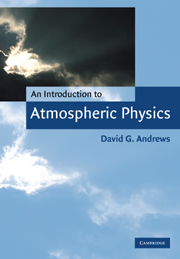Book contents
- Frontmatter
- Contents
- Preface
- 1 Introduction
- 2 Atmospheric thermodynamics
- 3 Atmospheric radiation
- 4 Basic fluid dynamics
- 5 Further atmospheric fluid dynamics
- 6 Stratospheric chemistry
- 7 Atmospheric remote sounding
- 8 Atmospheric modelling
- Appendix A Useful physical constants
- Appendix B Derivation of the equations of motion in spherical coordinates
- Appendix C Solutions and hints for selected problems
- Bibliography
- Index
1 - Introduction
- Frontmatter
- Contents
- Preface
- 1 Introduction
- 2 Atmospheric thermodynamics
- 3 Atmospheric radiation
- 4 Basic fluid dynamics
- 5 Further atmospheric fluid dynamics
- 6 Stratospheric chemistry
- 7 Atmospheric remote sounding
- 8 Atmospheric modelling
- Appendix A Useful physical constants
- Appendix B Derivation of the equations of motion in spherical coordinates
- Appendix C Solutions and hints for selected problems
- Bibliography
- Index
Summary
This chapter gives a quick sketch of some of the material to be covered in this book. We start in Section 1.1 with an outline of some of the more important physical processes that occur in the Earth's atmosphere. To interpret atmospheric observations we need to develop physical and mathematical models; they are briefly discussed in Section 1.2. In Section 1.3 two simple models are introduced; the second of these is a very basic representation of the greenhouse effect, which can be adapted to give some insight into aspects of global warming. In Section 1.4 we present a selection of observations of atmospheric processes, together with simple physical explanations for some of them. In Section 1.5 we briefly mention some ideas on weather and climate.
The atmosphere as a physical system
The Earth's atmosphere is a natural laboratory, in which a wide variety of physical processes takes place. The purpose of this book is to show how basic physical principles can help us model, interpret and predict some of these processes. This section presents a brief overview of the physics involved.
The atmosphere consists of a mixture of ideal gases: although molecular nitrogen and molecular oxygen predominate by volume, the minor constituents carbon dioxide, ozone and water vapour play crucial roles. The forcing of the atmosphere is primarily from the Sun, though interactions with the land and the ocean are also important.
- Type
- Chapter
- Information
- An Introduction to Atmospheric Physics , pp. 1 - 20Publisher: Cambridge University PressPrint publication year: 2000



